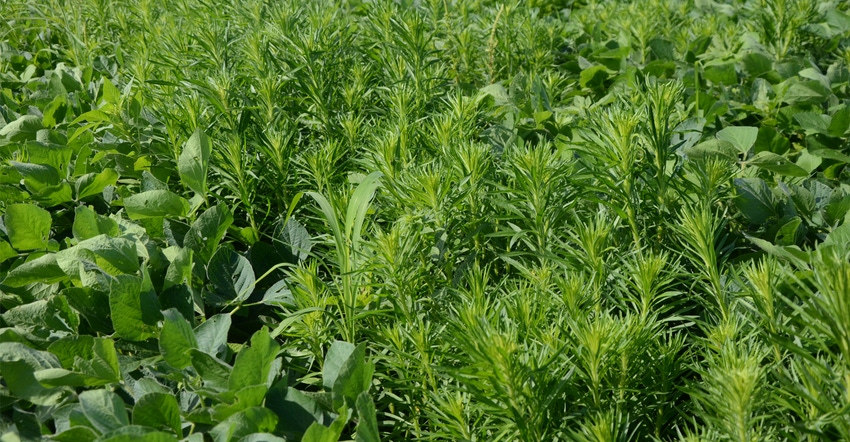February 23, 2021

Marestail is one of the most widespread and troublesome weeds in Iowa croplands. It can grow up to 6 feet tall, produce up to 200,000 seeds and can reduce soybean yields up to 80% if not controlled. Marestail seeds are light and disperse across landscapes with winds. Seeds have little dormancy and can germinate soon after seed shed.
In general, 75% of seedlings germinate in fall, remain in rosette-stage until spring, begin stem elongation in April and start flowering in July. About 25% of seeds germinate in the spring. Due to these unique biological characteristics and a prolonged emergence period, a comprehensive management program is necessary for marestail control.
Marestail populations in Iowa have developed resistance to glyphosate (herbicide group 9) and ALS-inhibitor (herbicide group 2) herbicides. Therefore, a diverse herbicide program is needed. Controlling marestail at the rosette stage is critical for consistent control with postemergence herbicides.
Control in rosette stage
As temperatures increase in spring, marestail stems begin to elongate. Plants in the rosette stage are much easier to control than bolted plants. Fall or spring burndown (preplant) herbicide programs play a vital role by targeting marestail at the rosette stage.
Field trials at the Iowa State University Research and Demonstration Farm near Ames in 2020 evaluated the effectiveness of several herbicide programs on marestail.

Figure 2. Effect of postemergence herbicides and application timing on marestail control in a bare ground study at three weeks after application. (Source: ISU Integrated Crop Management)
Engenia (dicamba) and Enlist One (2,4-D choline) both provided greater control of marestail when applied at the rosette stage compared to the bolting stage (Figure 2). In this study, Liberty (32 ounces per acre) provided greater than 90% control even when applied at the bolting stage of marestail plants; however, applications should be targeted to plants at the rosette stage for consistent control.

Figure 3. Efficacy of fall- or spring-applied preplant burndown herbicides on marestail control in Roundup Ready 2 Xtend soybeans. (Source: ISU Integrated Crop Management)
In an Xtend soybean trial, fall-applied BurnMaster (dicamba plus 2,4-D) or Scorch (dicamba plus 2,4-D plus fluroxypyr) provided complete control of marestail until early spring (April 15, 2020; data not shown). However, due to a lack of residual activity, new marestail plants emerged in the spring and percent control was reduced to less than 90% at the time of soybean planting (May 15, 2020) as shown in Figure 3.
98% effectiveness
In contrast, 2,4-D-based fall burndown programs that included a residual herbicide such as Panther SC (flumioxazin) provided greater than 98% control of marestail at soybean planting. No differences were observed when the residual herbicide was added to the fall or spring burndown programs (greater than 95% control). However, including residual herbicides (flumioxazin, metribuzin) in spring burndown applications is advised for consistent control of late-emerging cohorts of marestail and other early-emerging weed species such as common lambsquarters and giant ragweed before planting soybeans.
Glufosinate should be added in spring burndown programs with 2,4-D choline and dicamba in Enlist E3 (tolerance to glyphosate, 2,4-D choline and glufosinate) and XtendFlex (tolerance to glyphosate, dicamba and glufosinate) soybeans, respectively, especially when applications are delayed due to a wet spring or when marestail plants have bolted.
Ongoing research trials by the ISU weed science program indicate that fall-planted cereal rye cover crop would be an effective complementary strategy to manage or suppress marestail in soybean and reduce burden on herbicides.
Jha is an associate professor and Extension weed specialist with the Department of Agronomy at Iowa State University.
Source: Iowa State University Integrated Crop Management News, which is responsible for the information provided and is wholly owned by the source. Informa Business Media and its subsidiaries aren't responsible for any of the content contained in this information asset.
Read more about:
MarestailYou May Also Like




